Joe Beef
Montréal, Québec, Canada
Charles McKiernan was an Irish immigrant of near mythical stature who in the late 1800s opened a tavern in his adopted city of Montréal with the unusual moniker of Joe Beef’s (a nickname given to him while serving in the British army). In addition to maintaining a menagerie of wild animals in his establishment to the amusement of his patrons, McKiernan never refused service to anyone, regardless of their station in life; his pub was known as a place where the workingman could quaff a pint and enjoy a bite (preferably not from one of the wild cats he kept on the premises). In 2005, Chefs David McMillan and Frédéric Morin partnered with Allison Cunningham to open Joe Beef, a gastropub in the Petite Bourgogne (Little Burgundy) section of Montréal as a nod to McKiernan, offering a cornucopia of dishes inspired by traditional local cuisine and presented in a boisterous but casual environment. After several years they had opened luncheonette and wine bar McKiernan in the adjacent property, but after Joe Beef’s popularity skyrocketed to where it was booked to capacity a month in advance, the trio opted to expand Joe Beef into the space.
Today McMillan and company find themselves in the same predicament – after visits from a slew of food writers and media personalities including the Travel Channel’s dynamic duo of Anthony Bourdain and Andrew Zimmern and with the runaway popularity of the 2012 James Beard award-nominated book “The Art of Living According to Joe Beef: A Cookbook of Sorts”, they once again find themselves with reservations booked solid for a month and a half. Chef McMillan finds this to be a blessing and a curse – with no immediate plans to expand the Joe Beef name into an empire, he regrets that in addition to turning away customers who have become regulars over the years, they can’t even squeeze relatives of the staff into the tight quarters. McMillan has a deep appreciation for the locals who have faithfully returned on a regular basis to savor dishes from the ever-changing menu, a pick list that changes so frequently based on availability of ingredients and the whimsical imagination of the chefs that it is written on a blackboard daily. Although there are some favorite dishes that remain relatively unchanged, others transmogrify into variations on a theme. What appears on the menu one day as Pojarsky de veau (a traditional Russian dish featuring a veal meatball fried in butter) may on another occasion be made with sturgeon (an odd sight with what looks like a pork rib bone sticking out of it). Savory disks of pressed and grilled veal face with sauce charcutière have been shelved and brought back several times due to popular demand.
Chef McMillan loves the history and culture of Québec province, specifically its cuisine; he laments the fact that young, up-and-coming chefs study abroad and then return to their homelands prepared to turn traditional fare on its ear. As an example he imagines the reaction of a food adventurer who fulfills his lifelong dream to visit the Burgundy region of France to partake in the legendary cuisine, only to encounter a rock star chef having studied at a culinary school in New York who was so impressed with Thai cooking that the dishes now feature ginger, coconut milk and lemon grass. While McMillan has become the poster child for Montréal’s culinary culture, he also shows a great deal of humility, quick to recommend visits to other establishments representative of the local fare. Having been initially directed to Joe Beef to try the foie gras poutine, McMillan explained to me that his signature dish is the decadent and near ominous-sounding Foie Gras Double Down (a foil-wrapped, generous slab of maple-drunk smoked Cheddar and bacon with “chicken skin mayonnaise” sandwiched between two hefty cakes of deep-fried foie gras); he is quick to point out that foie gras poutine is the specialty of the house at legendary Chef Martin Picard’s Au Pied de Cochon, a restaurant that McMillan insists no visit to Montréal should be without. Extolling Chef Picard’s prowess, the topic of Québec’s cabane à sucre (maple sugar shack) culture comes up and Chef McMillan asks if I’ve seen Picard’s book, “Au Pied de Cochon Sugar Shack” which he has one of the staff fetch from nearby. He opens to a page that features a beautiful, full-color glossy photo of one of Chef Picard’s dishes from his sugar shack – a black squirrel on a plank, gutted and stripped of its fur except for the head, feet and tail and served as sushi, an image that is both enticing and horrific simultaneously.
Once McMillan gets started on regional cuisine, the conversation has my rapt attention as he touts the charcuterie at Restaurant DNA, then changes course to recommend trying guédille (a vegetable-laden hot dog in a bun sans hot dog) and a variety of poutines including poutine Dulton (made with ground beef, onions, and sometimes sausage), Michigan poutine (featuring sliced hot dogs), and the turkey-laced poutine Galvaude. He explains that although he has an affinity to foie gras, he recalls fondly that when he was in his Wonder years, foie gras was a traditional seasonal dish, served during the holidays in December and January. Taking advantage of a brief smoke break, Chef McMillan gave me an impromptu tour of the premises, showing me the custom-built smoker on the patio that can comfortably house the three little pigs, as well as the winter-bare vegetable and herb beds that would soon provide a bounty of fresh produce that will find its way into the kitchen. With reliable and trustworthy staff in place, McMillan has reduced his time on premises from what was almost residency to five days of normal human being hours.
The kitchen is relatively small, and the ability to move food out quickly defies physics (visualize a softball trying to make its way through a garden hose) and as artistically plated dishes whizzed by, I stood in slack-jawed, drool-soaked ecstasy – crispy, golden orbs of cornflake eel nuggets with tartar sauce, honey mustard and BBQ sauce; a simple, classic strip loin steak; falling-off-the-bone confit of Guinea hen; the ultra-popular lobster spaghetti (Spaghett Homard-Lobster, a tongue-in-cheek name that translates to Spaghetti Lobster-Lobster) coated in a creamy beige bisque; and a pair of massive, thick rib steaks (côte de boeuf) on the bone that could take down Andre the Giant.
Surprisingly, Chef McMillan detailed how the price and availability of wine and lobster is directly affected by consumption in Las Vegas; when the demand is high as poker stakes, the price for even regionally sourced luxury items ramps up. Price is a factor in one of the dishes I had the pleasure to try at Joe Beef – filet de cheval à cheval (roughly translated as “horse on horseback”). McMillan doesn’t get the furor surrounding the consumption of horse meat, a practice in French-bred Québec for centuries; Montréalers are accustomed to having access to many of the same cuts of the large mammal as beef. He explains that if he goes to market for meat and horse is at an economic advantage for a certain cut, it finds its way onto the menu. If a customer is offered a horse filet or beef tenderloin – they choose the dish by cut rather than content. The filet (which may also have been a filly) came to table bordered in bacon, smothered in a thick but light-colored Cafe du Paris sauce (made with chicken liver, cognac, truffle, parsley and cream) and crowned with a couple of sprigs of watercress. The dish was accessorized with thick French fry blocks Jenga’d on the side of the plate, perfect hand-held devices for mopping up the sauce. In terms of taste, Chef McMillan predicted with accuracy that it’s about the cut, not the mammal. The flavor was basic large farm animal; although (as McMillan points out) horse is a healthier alternative to beef in that it is lean, the meat was tender, juicy and delicious; the giveaway is most likely the scarcity of fat.
One of the other popular items I was fortunate enough to try is billed as “truck stop ham”, although I’ve yet to hit a truck stop that matched the aesthetics and taste of Chef McMillan’s creation. To create the specialty, suckling pig is spit-roasted, separated and pressed and then cut into blocks. The seared porchetta cube arrives wading in a shallow pool of smoked gravy and accompanied by wagon wheels of puffy, fried chicharrón and mashed potatoes. Since the meat was a conglomerate of chunks representing a wide array of porcine body parts, the cake was a jumble of wondrous tastes and textures – soft, fatty blobs; chewy, gristly bits; and salty, pink islands of lightly-fibered pig flesh, all sealed inside the substrate with a light char.
I was also intrigued with what McMillan described as borscht egg; the colorful dish was a party surrounding a perfect, flat-topped oval of beet aspic with a soft-boiled egg in its translucent center. Shavings of cold, pickled tongue lapped up against the gelatin while dollops of dill-garnished sour cream ran beneath; tiny cubes of red and golden beets were strewn about the landscape and two flat slices of crusty, airy bread stood at the ready for clean-up detail. A fork-side slice was all it took to release the yellow cascade of yolk across the plate, flavoring the dish with its rich, creamy lifeblood. I marveled at how they were able to shell and set the soft-boiled egg without breaking it and wondered how many tries it took before mastering that art. I initially thought the tongue to be a strange accoutrement, but in the resulting mélange the fatty meat worked exceptionally well.
While in the kitchen, Chef McMillan pointed out two lonely, naked disks of pressed veal face browning on the grill; we seemed to agree that some of the tastiest morsels of animal flesh can be found on the face and head. Served sans sauce, the dish showed off the almost blackened sear on the exterior; accents seemed to be an afterthought with cornishes, capers and deviled quail egg seemingly dropped in place. Like the truck stop ham, the veal face combined a variety of textures and taste, each of which were a pleasant and flavorful adventure in my mouth. Throughout the meal I nursed a bottle of Joe Beef Special Pils, a 5% beer bottled exclusively for Joe Beef by local brewery Bierbrier Brewing. Although I am admittedly a novice when it comes to pairing food with beer or wine, the brew had a light, almost sweet taste that didn’t obliterate the flavor of any of the dishes, a welcome quality appreciated more since I was foraying into a culinary landscape unlike any I’ve ever encountered.
A great many of the dishes mentioned are featured in Morin, McMillan and Erickson’s “The Art of Living According to Joe Beef: A Cookbook of Sorts”. The large-format volume is part cookbook, part historical reference, and part non-fiction drama about the birth and formative years of Joe Beef, with a look towards the future. On the end of the bar in the original room sits a golden trophy cup topped by a gilded pig; Food52.com‘s Piglet is awarded to the last cookbook standing after enduring a grueling competition judged by a panel of influential food industry folks. “The Art of Living According to Joe Beef: A Cookbook of Sorts” is the first Canadian entry into the competition; the book edged out Christina Tosi’s Momofuku Milk Bar cookbook in a final round judged by Alice Waters to win the 2011 Piglet. Although the insightful document provides the play-by-play on what goes into the creation of some of Joe Beef’s most popular dishes, my favorite aspect is the irreverent take on the recipes; nowhere is the dry humor more pronounced than in the recipe for Le Grand Setup de Caviar (on page 91) – I’m not about to spoil the fun here.
Chef McMillan is the consummate goodwill ambassador not only to Joe Beef, but to the rich history of the unique cuisine of Montréal and Québec province; my visit was an unparalleled gastronomic adventure that will not soon be forgotten. If you’re planning a trip to Montréal, plan ahead and at least jockey a seat at the bar – Joe Beef is the odds-on favorite to be one of Montréal’s preeminent dining destinations.
Joe Beef
2491 Rue Notre-Dame Ouest
Montréal, QC H3J 1N5
GPS Coordinates: 45°28’58.73″N 73°34’31.02″W
GALLERY: See images from Val’s visit to Joe Beef in Montréal, Quebec, Canada
NOTE: This cost for this meal was provided by the restaurant. The content provided in this article was not influenced whatsoever by the owners or staff of Joe Beef.

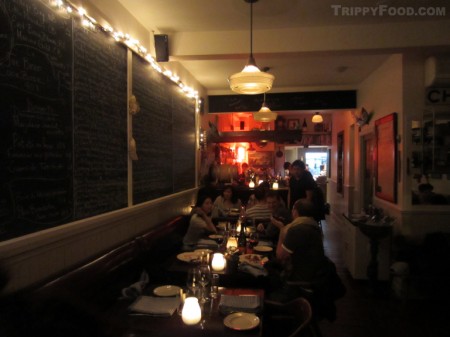
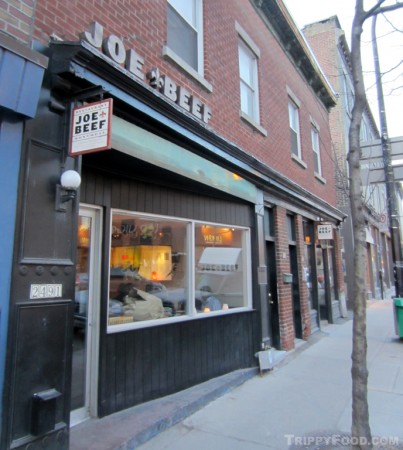
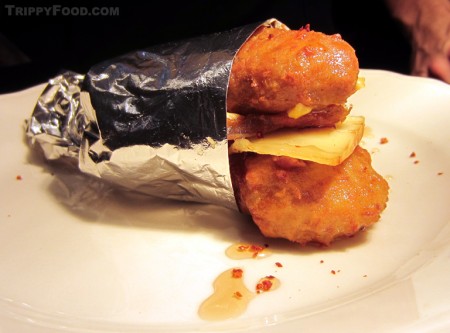
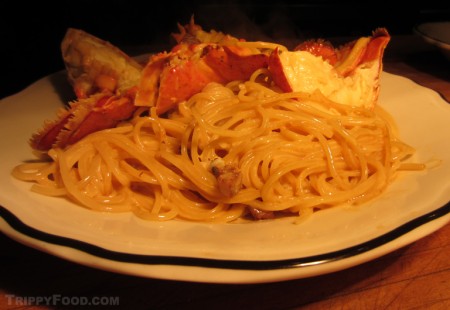
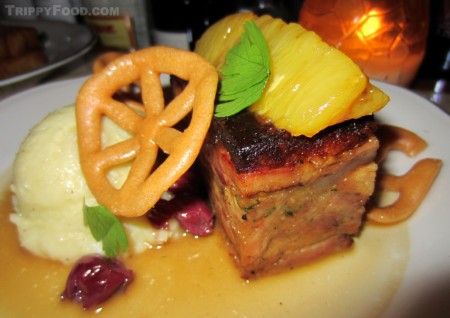
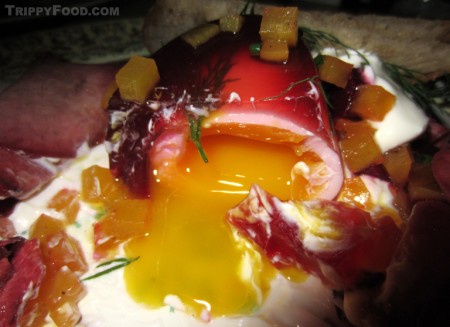
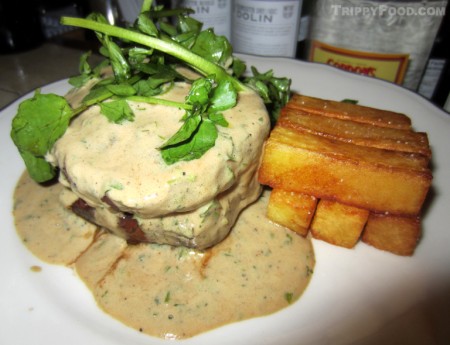
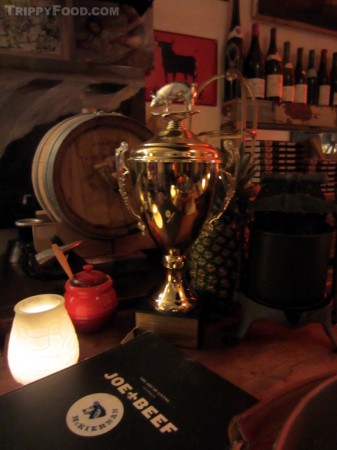
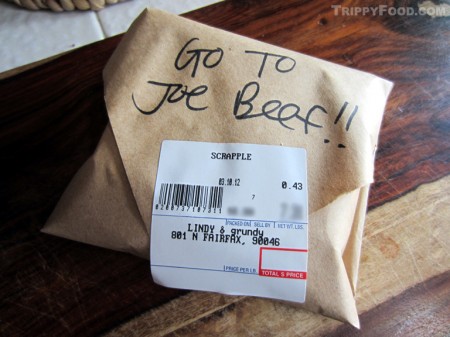

Great posts and pics as usual. There’s something about a chalkboard menu that just lights me up. Maybe it takes me back to grade school? Not sure. And hey, I love your site’s new look!
Thanks, Gary. I thought the blackboard concept was cool, too, but then I thought of the poor soul who has to update it daily. It takes me back to grade school, too, when someone in the class was assigned to go outside and “de-chalk” the big felt erasers; we did this by hurling them at the side of the brick building. I doubt they do that at Joe Beef…